Student file of Frank Twiss, a member of the Sioux Nation, who entered the school on October 6, 1879 and ultimately departed on February 14, 1884. The student did not attend the school continuously, but left and reentered. The file contains a former student response postcard, student information cards and a report after leaving indicating he…
Twiss, Frank
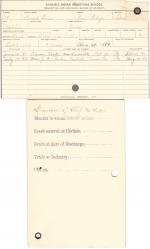

Student information card of Frank Twiss, a member of the Sioux Nation, who entered the school on October 6, 1879 and departed on February 14, 1884.
Note: Twiss married former student Adelia Lowe.
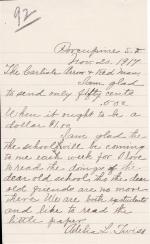
Student file of Adelia Lowe, a member of the Sioux Nation, who entered the school on November 30, 1882 and departed on March 6, 1896. The file contains student information cards, returned student surveys, a financial transaction, and a report after leaving. The file indicates Lowe was housekeeping in Porcupine, South Dakota in 1909.
In…
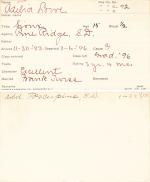
Student information card of Adelia Lowe, a member of the Sioux Nation, who entered the school on November 30, 1882 and departed on March 6, 1896. The information card indicates that Lowe graduated in 1896, married former student Frank Twiss, and was living in Porcupine, South Dakota in 1913.
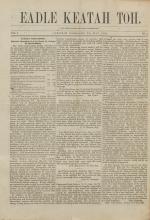
Page one opened with information, including statistics, from the Annual Report of the Commissioner of Indian Affairs about Carlisle and other schools as reported by Indian agents. Page two contains more arguments for, and accounts of support for, educating Indian youth. The article "Our Dining Hall" describes the physical space, the work the…
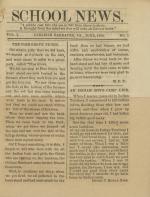
The first article by M. D. P. [Mason D. Pratt] describes a field trip to an iron forge near Pine Grove, followed by a picnic at the grove with the students, teachers, visiting chiefs, the college band and some invited guests. “An Indian Boy's Camp Life,” by Henry C. Roman Nose, gives a short account of his activities growing up. An "Editorial"…
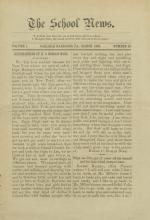
It opens with the conclusion to Roman Nose’s long journey to Carlisle. He explained how at Lee he learned to mow with a scythe and milk cows, before travelling to Carlisle Barracks, where he was happy to see other Indians following the “white man’s way”. Also on the first page is a small bit from Sophie Rachel (Nez Perces) on how she learned to…
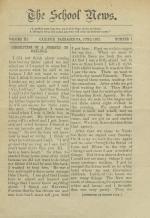
On the first page Justine A. LaFromboise describes her trip to Carlisle, explaining how her father convinced her to go get an education. The story continues on page four. On page two Ellis B. Childers (Creek) explained that he will be the editor while Charles Kihega (Iowa) visits home. C. Kihega examines the misconceptions whites and Indians…

Group portrait of Henry Thigh, Frank Twiss, Morgan (Young Bird), and Rebecca Big Star posed on the steps of a building, presumably on the school grounds.
Note: The Cumberland County Historical Society had previously identified the female sitter as Maud (Little Girl) based on interpretation of the caption. However, since Maud was…
![Seven Sioux students [version 1], c.1879 Seven Sioux students [version 1], c.1879](/sites/default/files/styles/views_taxonomy/public/image-photo/Potamkin%20%2317%20%28Choate%20%2321%29%20Full%20039.jpg?itok=r6uu1tl5)
Seven Sioux students posed on the bandstand on the school grounds shortly after their arrival. They are: Guy (Bear Don't Scare), Amos Lone Hill, Bennett (Singer), Frank Twiss, Lizzie Glode (also known as Daisy Glode), Lucy Day, and Mary (Lulu) Bridgeman.
![Seven Sioux students [version 2], c.1879 Seven Sioux students [version 2], c.1879](/sites/default/files/styles/views_taxonomy/public/image-photo/CCHS_sg0314.jpg?itok=tfRoCd0m)
Seven Sioux students posed on the bandstand on the school grounds shortly after their arrival. They are: Guy (Bear Don't Scare), Amos Lone Hill, Bennett (Singer), Frank Twiss, Lizzie Glode (also known as Daisy Glode), Lucy Day, and Lulu (Mary) Bridgeman.
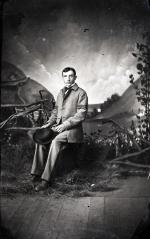
Studio portrait of Frank Twiss wearing school uniform.

Descriptive Statement of young people recruited for the Carlisle Indian School from Pine Ridge Agency, as prepared by the acting Indian Agent for Pine Ridge J. W. Alder. Of the 27 names on this list, only 18 ultimately traveled to Carlisle, the parents perhaps having changed their minds about sending their children. The names of the other 9 do…
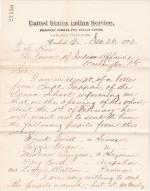
Richard Henry Pratt writes to the Office of Indian Affairs regarding a letter he has received from the Superintendent of the Genoa School to transfer five students to Genoa when the school opens in February 1884. Pratt states that while he is willing to send the students he does not believe the transportation costs should come out of his…
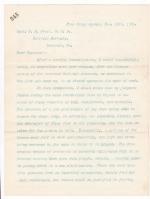
Richard Henry Pratt forwards a copy of a letter from George LeRoy Brown, Acting U.S. Indian Agent for the Pine Ridge Agency, to the Office of Indian Affairs. In Brown's letter he provides an update and a character assessment on former Carlisle Indian School students he has met.
